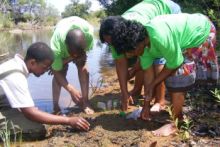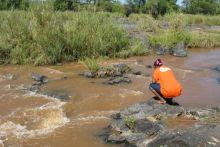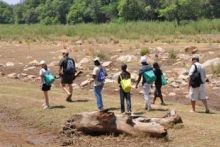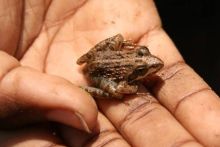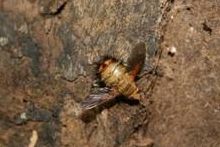SAEON Ndlovu and Kruger to Canyons Biosphere celebrate Biodiversity Day 2010
|
With 2010 being the International Year of Biodiversity, it was only fitting for the SAEON Ndlovu Node to support a close-to-home celebration of biodiversity by participating in the Kruger to Canyons Biosphere (K2C) Biodiversity Day on 6 November.
The K2C region is a proclaimed UNESCO Biosphere that stretches from the Kruger National Park (KNP) in the east to the Drakensberg Escarpment in the west. Within the Biosphere, K2C is working to establish a conservation corridor along the two largest rivers in the central lowveld — the Olifants and Blyde — with the aim of sustaining the rich biodiversity and vital ecosystem services associated with these perennial rivers.
The focus of this year’s event — which builds on a similar coordinated series of sampling activities held in 2008 — was to create awareness of riverine biodiversity within the K2C biosphere. The Ndlovu Node worked with K2C to involve over 100 volunteer observers (including learners, teachers, biodiversity specialists and industry representatives) at eight riverside survey sites. By carefully selecting sites inside and outside of protected areas, and up- and downstream of potential disturbances, the organisers hoped to raise the profile of rivers, both in terms of the ecosystem services they provide, and of the impact of development on them.
Ndlovu Node staff arranged logistics and participated on the day at three of the eight sites: Wild Rivers Estate (situated at the confluence of the Olifants and Blyde rivers), Cleveland Nature Reserve (a land-holding of Palabora Mining Company bordered by the Olifants River) and Mamba Weir (situated on the Olifants River within the borders of the KNP).
Volunteers gathered at the SAEON Ndlovu offices early on the day and were split into teams based on expertise before heading to one of the respective sites. Each team comprised biodiversity experts, grade 10 learners from the Node’s learner support programme, local teachers, representatives from several stakeholder groups, and the all-important rifle-bearer.
Biodiversity snapshot
Once on-site, teams were tasked with recording a ‘snapshot’ of the biodiversity present in or alongside the river — from the smallest aquatic invertebrate to the largest riverine tree. The diversity checklist was limited to plant and animal species seen only in the riparian zone — defined here as the river itself, all associated micro-habitats, and the adjacent flood plain (viz. channels, rapids, sand bars, rocks, reed-beds, riparian forest, etc).
The day was enjoyed by all who participated, and it was not only the learners who benefited from spending time with the scientists and other specialists. Working as a group provided the perfect opportunity for the various bird, aquatic, plant and reptile experts to share their knowledge with each, and everyone proved to be an enthusiastic, enquiring student! At the end of the four-hour sampling period, the teams of weary volunteers regrouped at the SAEON Ndlovu offices and compiled their final species inventories. Over 1 000 species were recorded across the eight sites.
Palabora Mining Company funded the event, which was further supported by K2C partners MTPA (Mpumalanga Tourism and Parks Agency) and LEDET (Limpopo Department of Economic Development, Environment and Tourism). SANParks also supported the event by allowing one team access to Mamba Weir within the KNP, and through the willing participation of several biodiversity experts and guides from within the KNP’s Scientific Services and Conservation Services departments.
K2C and SAEON Ndlovu appreciate all of the individual contributions that resulted in the successful hosting of the 2010 Biodiversity Day, but especially thank the learners and the independent experts from local clubs and societies for their participation.


